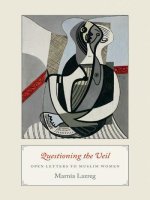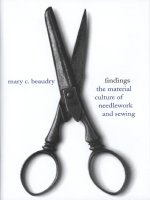princeton university press questioning the veil open letters to muslim women aug 2009
Bạn đang xem bản rút gọn của tài liệu. Xem và tải ngay bản đầy đủ của tài liệu tại đây (407.88 KB, 169 trang )
Questioning the Veil
This page intentionally left blank
Questioning
the Veil
Open Letters to Muslim Women
Marnia Lazreg
Princeton University Press
Princeton and Oxford
Copyright © 2009 by Princeton University Press
Published by Princeton University Press, 41 William Street, Princeton,
New Jersey 08540
In the United Kingdom: Princeton University Press, 6 Oxford Street,
Woodstock, Oxfordshire OX20 1TW
All Rights Reserved
Library of Congress Cataloging-in-Publication Data
Lazreg, Marnia.
Questioning the veil : open letters to Muslim women / Marnia Lazreg.
p. cm.
Includes bibliographical references and index.
ISBN 978-0-691-13818-3 (hbk. : alk. paper) 1. Muslim women.
2. Hijab (Islamic clothing) 3. Veils—Religious aspects—Islam. I. Title.
HQ1170.L39 2009
297 5'76—dc22
2009003499
British Library Cataloging-in-Publication Data is available
This book has been composed in Adobe Caslon Pro
Printed on acid-free paper. ∞
press.princeton.edu
Printed in the United States of America
1 3 5 7 9 10 8 6 4 2
In gratitude to the memory of my mother,
whose openness on the world and indomitable will to
freedom nurtured me and continue to inspire me.
We are not [wo]men for whom it is a question of
“either-or.” For us, the problem is not to make a utopian
and sterile attempt to repeat the past, but go beyond it.
—Aimé Césaire, Discourse on Colonialism
Contents
Acknowledgments ix
Introduction 1
Letter One
Modesty 15
Letter Two
Sexual Harassment 41
Letter Three
Cultural Identity 53
Letter Four
Conviction and Piety 67
Letter Five
Why Women Should Not
Wear the Veil 97
Notes 133
References 147
Index 153
This page intentionally left blank
Acknowledgments
Writing these letters was not an easy task: it required
me to say things I normally would not have said about issues that had troubled me in the past but which I let alone
with the hope that they might just come to pass. But they
have not, and facing them meant facing myself, drawing
on bits and pieces of my life to explain myself at the risk of
whittling away at that special zone of privacy that I treasure
so much. However, there are situations when commitment
to change makes it incumbent on the writer to reveal herself
as a person and put down the theoretical and methodological shields that usually ensure a semblance of detachment. I
offer these letters in a spirit of candor.
I deeply appreciate the trust that all the women I interviewed placed in me by sharing with me their thoughts and
feelings. I have reproduced their words with accuracy, and I
hope that my interpretation of their experiences is helpful to
them and will contribute to a better understanding of the issue of veiling. I must also thank Sondra Hale for taking the
time to read the manuscript and for her incisive comments.
x
Acknowledgments
I have a special debt of gratitude toward my editor, Brigitta Van Rheinberg, who was receptive to the idea of writing these letters, encouraged it, and supported it. I could not
have completed this project without her sustained commitment and dedication.
A number of people helped in researching the relevant
materials. Akim Oualhaci’s superb research skills were immensely useful in making sense of the headscarf controversy in France, and understanding the French construction
of Muslim identity. Louisa Rachel Khettab volunteered her
time to scour bibliographical sources. Jean-Jacques Strayer
at the Jacqueline Wexler Library (Hunter College) was always ready to provide expert assistance whenever I needed
it. Last but not least, Curtis Matthew, head of the Circulation Department, Mina Rees Library (Graduate Center of
the City University of New York), gave me access to precious sources in a period of crunch. I cannot thank him
enough for his generosity and diligence.
Questioning the Veil
This page intentionally left blank
Introduction
In my previously published work, I have consistently
objected to the manner in which Muslim women have
been portrayed in books as well as the media. On the one
hand, they have been represented as oppressed by their religion, typically understood as being fundamentally inimical to women’s social progress. From this perspective, the
veil has traditionally been discussed as the most tangible
sign of women’s “oppression.” On the other hand, Muslim
women have been described as the weakest link in Muslim
societies, which should be targeted for political propaganda
aimed at killing two birds with one stone: showing that
Islam is a backward and misogynous religion, and underscoring the callousness or cruelty of the men who use Islam
for political aims. Such a view made it acceptable to hail the
war launched against Afghanistan in 2001 as a war of “liberation” of women. Subsequently, the American-sponsored
constitutions of both Afghanistan and Iraq were lauded as
protecting the “rights” of women in spite of evidence to the
contrary.1 In this context, any Muslim woman who takes
2 Introduction
cheap shots at Islam and crudely indicts Muslim cultures is
perceived as speaking the truth and is elevated to stardom.
I do not wish to enter the fray on one side or the other
of the ideological struggle for or against Islam. I have no
animus against Islam. I was born to a Muslim family in
a predominantly Muslim country, and I am proud of my
heritage. I have decided to write these letters to women
whose religion is Islam and who either have taken up the
veil or are thinking of wearing it. However, writing about
women necessarily means writing about men. To many in
the Muslim world, well-meaning individuals beleaguered
by geopolitical events, these letters may seem pointless. But
perhaps such individuals need to resolve the apparently unimportant issue of veiling before they can defend themselves more effectively. These letters are also relevant to all
people, women and men, seeking to understand the human
experience. I have reached a point in my life when I can no
longer keep quiet about an issue, the veil, that has in recent
years been so politicized that it threatens to shape and distort the identity of young women and girls throughout the
Muslim world as well as in Europe and North America.
A reveiling trend that emerged in the past two decades
in a number of countries has recently gathered momentum. This trend is sustained by a socially conservative mood
that spread over the Muslim world, the dissemination of
faith-based literature extolling the home-making vocation
of women, as well as a renewed or intensified involvement
of men in matters pertaining to women’s dress and deportment. I have walked into stores in Algiers where owners
played CDs of speeches from self-styled religious leaders
exhorting women to cover their bodies and attend to their
wifely duties. I have seen prepubescent girls wearing a
tightly wrapped scarf around their head atop a long skirt,
Introduction 3
holding hands with their similarly attired mothers. I do not
have a daughter, but the sight of these young girls stirs feelings in me that disturb me as a woman and an intellectual. I cannot be a spectator before a trend that I strongly
believe is misguided and limits women’s capacity for selfdetermination in their bodies as part of their human development. I address the veil, not from its overwrought and
contrived exegetic religious angle, but as an essential part
of a trend that is largely organized and thus detrimental to
women’s advancement.
These young girls remind me of an experience I had
when I was about seven years old while I was playing with
friends outside of my home. A boy, the son of neighbors,
had pulled my braids from the back while making lewd
movements with his body. Alerted by my cries for help, my
mother opened the door of our house and took in the scene.
Since time was of the essence, she could not go back inside
and put on her white veil. Instead, she pulled one of her
clogs off her foot and threw it at the boy, missing him. The
clog landed on my forehead, making a bloody gash. I had a
half-inch scar for many years to remember the incident by.
Had my mother not been thoroughly socialized in the culture of the veil, she would have simply walked the twenty
feet or so that separated her from my attacker. Thirty years
later, she discarded her veil. In retrospect, I wonder whether
that incident had somehow worked through her unconscious mind and prepared her psychologically for the removal of her veil. The street we lived on was in a residential
area, and there were few men around during working hours.
My mother could have crossed it with no one noticing her.
But she could not and did not. As I grew older and reflected
on the incident, I wondered what would have happened
had the boy been older and carried a weapon. Would the
4 Introduction
veil have prevented my mother from saving my life? Probably not, but the power of socialization on the mind cannot be easily dismissed. The veil was part and parcel of her
persona; she could not be outdoors without it. She had felt
utterly paralyzed before throwing her clog at the boy. Since
then, many women have been able to disentangle their
sense of self from the veil. But today organized efforts are
made to resocialize women into the culture of the veil with
the help of a whole array of frequently contradictory arguments as well as the apparent consent of some women.
To those of us who have pondered the issue, the veil inevitably makes us uneasy about its fundamental unfairness
to women. The Algerian writer Kateb Yacine remembered
telling his mother, who was walking him to the Turkish
bath, to draw her veil over her head when she let it slip off
(most likely her face and head) to breathe freely. Mother
and son were on a deserted road, yet the son peremptorily
ordered his mother to “put back your veil!” He wondered,
years later, how he could have insisted that his mother keep
her veil in place when she was out of reach of men’s gaze,
and whether he had not “somehow contributed to the seclusion of women.”2 He acted as her censor, oblivious to her
desire for freedom in her body—a freedom that he enjoyed
as a matter of fact. This thought haunted him. Yacine was
one among many men who made sure that their women
relatives remained in the folds of their veils.
When I was growing up, my uncle would take me, along
with my aunt and my mother (both of whom were veiled
from head to foot), for refreshments in the middle of the
summer to a French ice-cream parlor by the shore that catered mostly to French customers. The peak moment for
me was to observe my aunt and mother strenuously maneuver the tall glasses filled with cold juice and the long
Introduction 5
straw under their white veils, bending their heads over
while drawing the top of their veils in such a way that they
could free the right hand that secured the veil over the face
according to the style that left an opening for one eye only.
It was a delicate maneuver that took a few seconds, during
which I expected the glass to fall and break, causing all the
customers to turn around and look at us. My uncle was a
highly knowledgeable man in matters of religion. He wore
a red shesh with a black tassel that bounced in the air as
he walked, and traditional pleated pants (sarawal ) topped
by a shirt, tie, and jacket à la franỗaise. He fancied himself a modernist but never said to my aunt or my mother
that they could uncover their faces and enjoy their drinks,
that the Quran did not enjoin a woman to conceal her face.
Nor did he tell them that religion is not supposed to cause
unnecessary hardship—another Quranic principle. Yet he
used to lecture others about their misconceptions of their
religion. His modernism was limited to taking his veiled
wife and sister-in-law to an all-French spot where French
women and men sipped refreshments side by side.
The normalization of the veil, its power over men’s (as
well as women’s) minds, can be so blinding as to be deadly. In
March 2002 Saudi media reported that fifteen girls died in
a fire that erupted in their school in Mecca because the vice
police (mutawwa) prevented firefighters from approaching the screaming girls on the grounds that the girls were
not wearing the proper dress (a scarf over the long black
‘abaya), and contact with them would be sinful. A father was
quoted as saying that “the school watchman even refused
to open the gates to let the girls out.”3 Firefighters had to
confront the police in order to save lives. I am not reporting
this incident for its sensationalism, but to indicate that it
stands at the other end of the veil culture continuum: at one
6 Introduction
end, my mother’s inability to get out of the house and help
me without anyone preventing her from doing so except
her oversocialized self; at the other end, the special police
squads enforcing the virtue of the veil at the risk of bringing
death to women. In between there are as many variations of
attitudes as there are styles of veiling. Such is the power of
the veil that it captures the imagination, frustrates, coerces,
inspires, and disempowers.
The reveiling trend coincides with an approach espoused
by academic feminists that seeks to correct the notion that
the veil is a sign of “oppression” but in reality makes oppression more intellectually acceptable. Although acknowledging that veiling may reinforce gender inequality, this
approach uncritically and apologetically foregrounds lowermiddle-class women’s stated reasons for taking up veiling.
Its proponents engage in various degrees of sophisticated
theoretical hair-splitting in order to excavate the operative
agency assumed to be lurking behind the veil, subverting its
use, and turning it into a tool of empowerment. The implication is that the “oppressed” are not so oppressed after all;
they have power. Faced with this newly discovered power
frontier, the researcher does no more than study its manifestations.4 She finds power in a woman’s decision to veil
herself, and the veil is hailed as securing a woman’s ability to work outside her home, or protecting her husband
from experiencing jealousy. In bending over backward to
“give women a voice,” adherents to this approach find it
necessary to dismiss the reality of the women who object to
veiling. These are routinely disposed of as being “elite,” “upper class,” and “Westernized.” Implicitly, apologists for veiling seek to disempower local women who have a different
understanding of veiling from theirs and to delegitimize
these women’s views while at the same time validating their
Introduction 7
own as those of dispassionate outsiders, intent upon discovering the truth of veiling or reveiling against the “Westernized” native. In this way, the outside expert shifts the charge
of bias onto the “elite” native woman-qua-“Westernized.”
One woman elevates herself as a social-class avenger and
decipherer of the hieroglyphics of the subject behind the
veil; the other is banished from the realm of personhood
altogether as she is deemed to only mimic the “Western”
woman. It is tempting to interpret this approach as a form
of intellectual masochism on the part of the researcher who
dismisses the native woman as “Westernized” because she
wishes nothing more than to not have to contend with the
veil thing, just as the researcher does not. It represents, in
fact, a new form of prejudice.5
My intent is not to defend the upper classes of the Middle East. Rather, I wish to draw attention to the continued
and problematic academic investment in an area of Muslim
women’s lives in either a prejudicial or an apologetic mode.
The hidden premise of the apologetic approach is that the
veil is unquestionable because its wearers purportedly assume it to be so, and as long as they “choose” it, our task as
researchers is to reveal its benefits for them. The veil, once
again, emerges as a field of struggle, not only between men
and women, as it has been historically, but also between native women (opposed to it) and women from non-Muslim
cultures, or those hailing from Muslim cultures who support veiling in one way or another. Furthermore, the academic sanctioning of the veil turns it into a fixture of the
Muslim landscape instead of an evolving phenomenon.6
From my perspective, veiling is not reducible to its rationalizations, be they theoretical, social-psychological, economic, or political. By the same token, veiling is not about
the “right” of a woman to wear or not wear one kind of veil
8 Introduction
or another. Rights are political matters, as has been shown
in the headscarf controversy that has engulfed France since
1989 and, more recently, Turkey. In France, the state passed a
law (referred to as laïcité) on March 17, 2004, denying young
French Muslim women the right to attend public schools if
they wear headscarves. In Turkey, the state availed itself of
the French law of laïcité to reinforce a long-standing prohibition against veiling in public educational institutions
and compel faculty members to report and expel from their
classes female students wearing headscarves.7 The Erdogan
government’s attempt to remove the ban on headscarves
in the spring of 2008 threw Turkey into turmoil similar to
France’s. The attempt was overturned by the Turkish high
court as unconstitutional.8 These controversies are part of
the background of many women’s decision to take up the
veil. However, it is noteworthy that in both countries the
veil has been made to represent something other than itself:
proselytism as well as the incursion of religion—deemed
backward—in politics, and thus an affront to secularism.
French opponents of the scarf equated it with “sexual apartheid,”9 and the former president of France, Jacques Chirac,
called it flatly an act of “aggression” against French values.10 In both instances, the decision that a woman makes
to dress the way she pleases for whatever reason is denied.
The politicization of the veil—its forced removal or its legal enforcement (as in Iran and Saudi Arabia)—hampers
women’s capacity to make a decision freely, just as it also
compels them to abide by an intrusive law at the expense
of their own conscience and judgment. More important, it
contributes to confounding the veil question by defining
it unambiguously as religious, even when the religious texts
lack clarity and determinacy in the matter. In this sense,
the intrusion of the state in women’s lives in support for or
Introduction 9
against the veil stacks the deck against women and makes
them vulnerable to giving undue credence to arguments
provided by one side or the other.
I do not approach veiling from the perspective of the
struggle between “tradition” and “modernity,” which purportedly women resolve by opting for the veil, as a number
of studies have claimed.11 New styles of veiling are less confining to a woman’s ability to move about than the old ones,
and a number of veiled women throughout the Muslim
world have been carrying out their professional activities
side by side with men in their workplaces. Nor do I consider
wearing a veil at work as ushering in a new form of “modernity.” Furthermore, I do not intend to characterize veiling as representing women’s “alienation,” “enslavement,” or
“subjugation” to cultural norms. Such characterizations are
unhelpful as they can easily be applied to our postmodern
condition, marked as it is by a retreat from a meaningfully
shared human experience and the flaunting of privatized
forms of consciousness, which result in conceptions of
women that are as detrimental to women’s integrity as the
veil might be. I instead approach veiling from an existentialphilosophical standpoint that peels away the justifications
that women who wear it or intend to wear it usually invoke.
This is a delicate endeavor as the risk is great that a woman’s
rationale for wearing a veil might be discounted as a form
of false consciousness, and her agency dismissed as illusory.
As a social scientist, I cannot deny women’s agency or substitute mine for theirs on grounds that I am more equipped
to make sense of their motivations than they are. By the
same token, mystifying rationalizations are not necessarily
expressions of false consciousness or “agency.” However,
agency is not a free-floating capacity independent of the
social framework within which it expresses itself; neither
10 Introduction
is it above questioning. At the same time, veiling involves
me as a woman who grew up with relatives, neighbors, and
friends who wore, or still wear, a veil. Veiling is existentially
familiar to me; it has been part of my life even though I do
not and will not wear a veil. Because in the popular imagination, in the Muslim world as well as in the “West,” veiling has come to represent the essence of Islam, little space
has been made in which this practice could be examined
outside the framework of religion, or for its potentially deleterious psychological effects.
There has been a change in women’s perceptions of the
veil in the Middle East and North Africa. The generation
of women that came of age in the 1950s and 1960s when
a number of countries recovered their political sovereignty
seldom took up the veil in urban centers. Coinciding with
the emergence of the Islamist movement, the 1970s and
1980s witnessed a trend toward the use of veiling. Women
explained their turn to the veil as the result of a heightened
consciousness of the place and meaning of religion in their
lives; a way of showing modesty in their dress; a protection against sexual harassment or undesirable looks from
men; and a political statement, especially among women
relatives of men who joined the Islamist movement. In the
aftermath of September 11, 2001, the veil acquired a new
meaning in Western countries as a demand for acceptance
by non-Muslims and, by the same token, a manner of fighting prejudice by flaunting difference. In the context of the
headscarf controversies in France, the veil has also been
hailed as a tool of “liberation” for women—from imposed
“assimilation” into the majority culture and, for some, from
their parents’ strict control of their movements. The most
difficult argument to unravel is that of faith and conviction.
I respect the woman who, after studying religious texts,
Introduction 11
concludes that it is incumbent upon her to veil herself, or
that without a veil she would be living in a state of sin. I
would, however, doubt her commitment to the veil if she
has simply followed the opinion of others—men or sometimes women of religion—about the religious meaning of
the veil. Faith is a personal matter even if religious practices
involve the community of believers. Nevertheless, considering that the woman question in Middle Eastern cultures
has traditionally been a thorny one, it is crucial that any
woman who decides to wear any type of veil examine her
conscience and determine whether the veil is the only manner for her to fulfill her spiritual needs. Because of both
its role in the history of women’s exclusion from social life
outside the home and its resilience, the veil is overlaid with
meanings that cannot be simply brushed away because a
woman says so. Whenever a woman wears a veil, her act
involves other women, including the girl child.
Veiling is both a discourse—a manner of thinking and
talking about it, perceiving it as well as taking it for granted—
and a practice. As a discourse it lies at the interface of political ideology, culture, and agency. As a practice, veiling cannot
be detached from history. And it is as history—the history of
women in relation to men—that it is lived and experienced
by women in various parts of the world. Conflating discourse
and practice “naturalizes” veiling by making it appear normative and immutable. The veil as history informs the veil as
discourse, sheds light on its modalities, and helps to make
out its future evolution.
The open letters that follow are offered as an invitation
for greater reflection on the reasons for which women are
reclaiming the veil as a constitutive part of their identity, defending it, and describing it as a means of “liberation.” Over
the past fifteen years, I have spoken with and interviewed
12 Introduction
numerous women, old and young, in the Middle East, North
Africa, France, and the United States who have worn one
type of veil or another; women who took off their veil for a
while but felt they had to put it back on; and women who
have been thinking of wearing one. I take these women’s arguments seriously but wish to subject them to scrutiny as
I am convinced that only rational reflection can advance
women’s understanding of themselves, particularly in times
of political turmoil. For what is at stake is how women think
of themselves when they are discussing religious matters, implementing what they might think is God’s will, substituting
religious norms for political action, or (more important) retreating into custom as a means of political protest. I explore
the various angles of women’s reasons and justifications for
veiling, question them, and draw all the necessary conclusions, including those that might be disturbing, be unsettling, or go against the grain.
Given the history of misunderstanding of Islam as a religion and culture, there is no language in which to speak
about the veil meaningfully without conveying to the
reader that one is either denigrating or apologizing for a
very rich culture with its inspiring ideals as well as less elevating customs. Hence I use terms that need clarifying.
The expression “Muslim women,” for example, does not
mean that all women living in countries where Islam is the
main religion are necessarily devout or in agreement with
the veiling custom. Rather, it refers to the women who have
taken up the veil as a way for them to display their religious
affiliation. The best but cumbersome way to refer to these
women would be “women-who-wear the veil-because-they
think-it is-a religious-obligation-in Islam.” There is no generic “Muslim woman,” just as there is no generic “Christian woman”—only concrete women engaged in concrete









